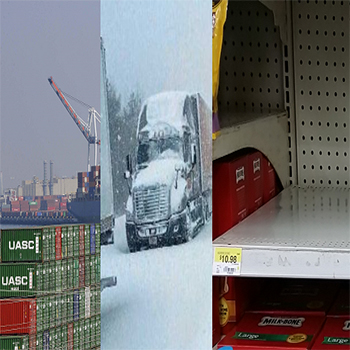How Demand Sensing Mitigates Crisis Situations

In the same way that demand sensing can be used to monitor and mitigate on-shelf availability during extraordinary conditions, so can it be used for day-to-day operations.
The West Coast ports deal was welcome news to retailers and Consumer Packaged Goods (CPG) companies.
Productivity at the ports, which handle over 40% of US trade, has been down by as much as half since November when the crisis started.
While work is returning to normal, it will still take months to clear the logistics backlogs, so the ripple effect from the port to the retail shelf may be with us for some time or may increase total logistics costs.
What is this “ripple effect”?
The ports crisis impacted CPGs in several ways – delaying shipment of either finished goods, subassemblies, components, raw materials or parts.
Some manufacturers shipped by air, while others diverted to other ports. Goods shipped through other ports then needed to be transported by rail, truck, intermodal, or air within the US to get to their final destinations – potentially adding to the delays. These delays ripple through the supply chain and create out-of-stock situations throughout retail channels.
We see a similar ripple effect with the extreme winter weather being experienced by much of the North East. When roads are impassable due to snow and ice, trucks can’t get to distribution centers, or from distributions centers to stores.
Even if the truck gets to the DC or store, weather conditions may mean the facility is short-staffed – delaying unloading or stocking – and resulting in out-of-stocks or other inventory bottlenecks. The weather, per se, can also cause demand to spike via pantry loading.
While such crisis conditions are unusual, the resulting ripple effects can be monitored, managed and mitigated through use of demand sensing and analytics solutions like Orchestro’s ShelfSense.
By monitoring demand across multiple retailers, nationwide, supply chain professionals and company executives can get a clear view of whether, where and when these types of crises might impact shelf availability.
They can also understand whether the impact is geographic, retailer-specific or product-specific. With these insights in hand, they would know where to focus attention, or where to expedite shipments or redirect inventory in order to minimize the impact.
Demand sensing has far broader application for CPGs than crisis mitigation. In the same way that demand sensing can be used to monitor and mitigate on-shelf availability during extraordinary conditions, so can it be used for day-to-day operations.
Other demand signals can be used to monitor and manage promotion execution, daily in-store execution tasks or new product introduction.
The key is to cast a wide net – collecting and harmonizing signals from all of your major retail channels, combining them with internal data and then deriving insights.
By including all of your channels, the insights you derive can look at geographies or products independent of retailer, or deliver comparisons between retail channels on an apples-to-apples basis.
Article Topics
Orchestro News & Resources
E2open Acquires Analytics Leader Orchestro How Demand Sensing Mitigates Crisis Situations The State of Inventory Management - 2015 The 3Ps to Eliminating Out-of-Stocks: A New Paradigm for Inventory Management The Problem with Traditional Inventory ManagementLatest in Technology
The Top 10 Risks Facing Supply Chain Professionals Walmart’s Latest Service: Ultra Late-Night Delivery South Korea Finally Overtakes China in Goods Exported to U.S. SAP Unveils New AI-Driven Supply Chain Innovations U.S. Manufacturing is Growing but Employment Not Keeping Pace The Two Most Important Factors in Last-Mile Delivery Spotlight Startup: Cart.com is Reimagining Logistics More Technology













